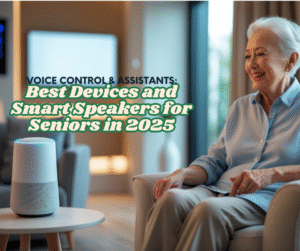As an Amazon Associate, we may earn a commission if you make a purchase — at no extra cost to you.
Accessible Tech: Best Smart Home Devices for Seniors to Enhance Safety and Independence
The right smart home devices can make life easier, safer, and more comfortable for seniors. Many older adults want to stay independent, but everyday tasks can become more challenging over time. Technology made for seniors is now simple to use and can help with things like medication reminders, calling for help in emergencies, and turning lights on and off with just a voice command.
Table of Contents
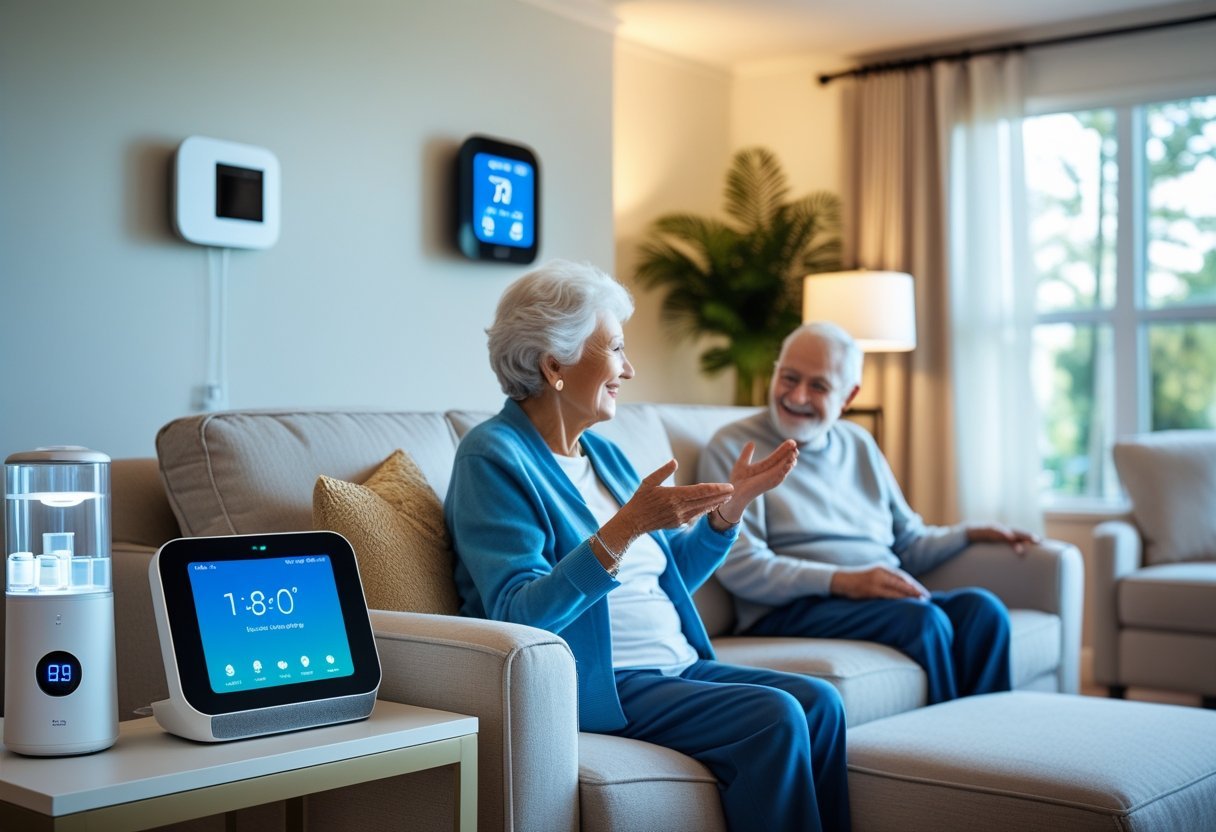
Devices like voice-activated assistants, smart pill dispensers, and user-friendly smart lights bring real support for older adults at home. These products can be set up quickly and used without complicated setup or technical skills. Families can feel better knowing their loved ones have extra help.
Key Takeaways
- Smart home technology can support seniors’ independence and safety.
- Simple devices make daily tasks and emergencies easier to manage.
- The right tools offer peace of mind for both seniors and their families.
Voice-Activated Assistants for Senior Safety
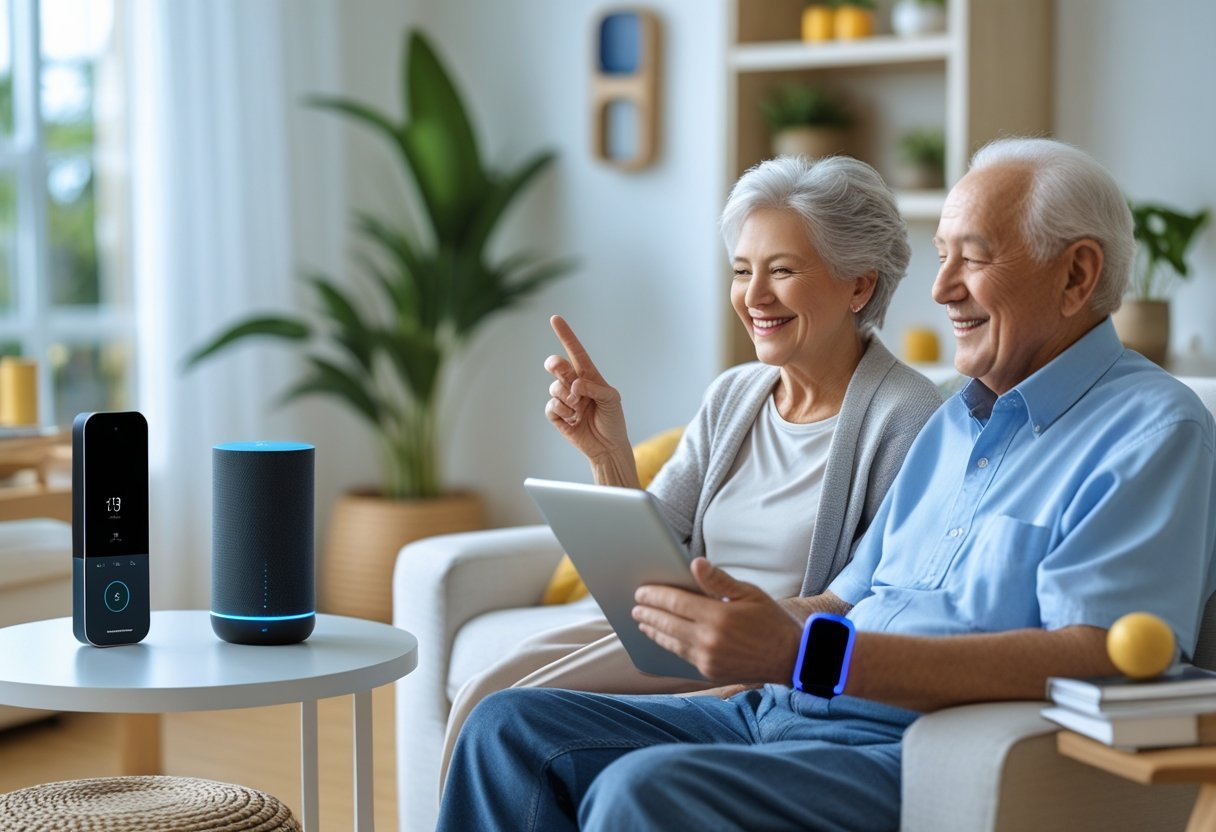
Voice-activated assistants like Amazon Alexa and Google Nest can help older adults feel more secure at home. These devices are simple to use with only voice commands, making them accessible even for those who are not comfortable with smartphones or computers.
- MEET THE ALL-NEW ECHO SHOW 15 – A stunning 15.6″ Full-HD (1080p) smart display that’s perfect for…
- FAMILY ORGANIZATION HUB – See your top widgets at a glance, like your family’s calendars and to-do…
- ALL YOUR FAVORITES, ALL RIGHT HERE – Built-in Fire TV unlocks endless entertainment, so you can…
- VALUE BUNDLE INCLUDES: Google Nest Hub 2nd Generation with English, Spanish, French and Portuguese…
- IT WORKS EVERYWHERE Easy to use and will automatically start up in English when connecting to your…
- BLENDS RIGHT INTO YOUR HOME Looks great on a nightstand, shelf, countertop – or the wall. This Nest…
Last update on 2025-10-02 / Affiliate links / Images from Amazon Product Advertising API
Emergency Response Features
Voice-activated assistants can connect to emergency services or family members quickly. Some devices work with medical alert systems. With a simple command like, “Alexa, call for help,” the assistant can contact pre-assigned emergency contacts.
These assistants also support optional subscription services that provide direct access to 24/7 urgent response teams. Devices can be set up to announce reminders for regular check-ins or wellness calls. Most assistants maintain a log of calls and commands, which family members can review for added safety.
In homes with smart door locks, users can unlock the front door for emergency responders without leaving the room. Voice-activated devices also work with fall-detection sensors and panic buttons.
Daily Reminders and Scheduling
Assistants make it easy to keep track of medication times, appointments, and other daily tasks. They can announce reminders out loud at set times. For seniors who sometimes forget appointments or daily routines, this feature can be very helpful.
Users only need to say, “Remind me to take my pills at 8 AM,” and the assistant will give a spoken alert daily at that time. Family members can set up reminders remotely if needed.
The device can read out lists, notes, and even the weather for the day. Some can sync with calendars and alert the user to upcoming events or deliveries.
Hands-Free Home Control
Controlling home devices with voice commands can make life easier and safer. Seniors can turn on lights, adjust thermostats, or lock doors by speaking instead of getting up.
Most assistants work with many smart home products, including smart bulbs, plugs, and appliances. This setup helps those with mobility issues avoid extra steps or possible falls. For example, a senior can say, “Turn on the living room light,” without having to search for a switch.
Using routines, multiple actions can happen with one command. Saying, “Alexa, start my day,” could turn on lights, adjust the thermostat, and read out the news. This hands-free setup helps seniors stay comfortable and in control in their own homes.
Smart Pill Dispensers and Medication Aids
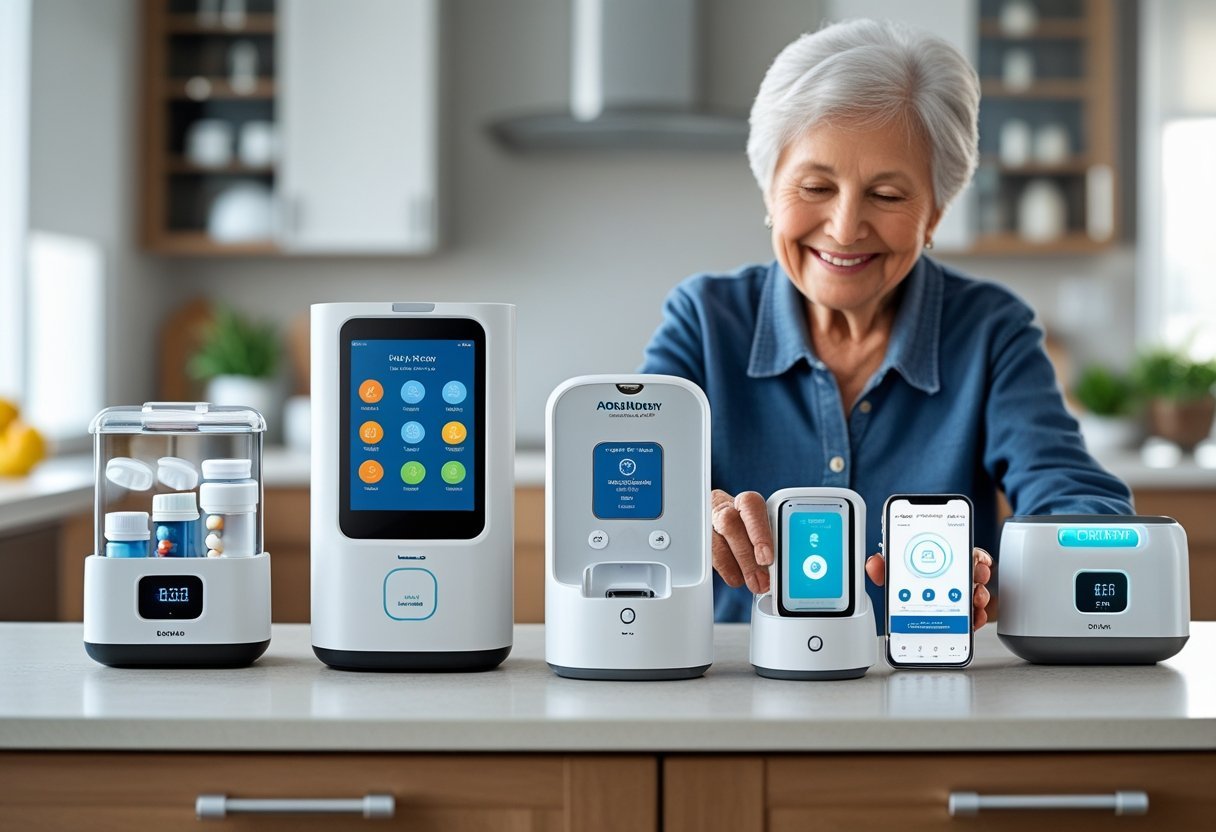
Smart pill dispensers support older adults in taking their medicine on time and in the right dose. These tools can help prevent missed doses, medication mistakes, and confusion, especially for those who have to take many pills every day.
- 【Ideal Gifts for your love】 Smart pill box’s exquisite appearance and Multi-function reminder is…
- 【Smart Pill Organizer】Our smart pill box is easy to set up via Bluetooth connection to an APP,…
- 【Multiple Reminders】 7 day pill organizer gives you multiple reminders to remind you to take…
- 【Never Miss a Pill】: Our automatic pill dispenser ensures you never forget to take your…
- 【Easy to use】: Our pill organizer simplifies your medication management. With multiple reminders…
- 【Hassle-Free Access】: Say goodbye to struggling with stubborn pill lids. Our daily pill…
Last update on 2025-10-02 / Affiliate links / Images from Amazon Product Advertising API
Automated Medication Reminders
Smart pill dispensers often include built-in alarms or smartphone notifications. They remind users to take their medication at the correct time. Many devices have audible beeps, flashing lights, or even spoken alerts.
Some dispensers connect to an app, which can send reminders to a phone or tablet. This helps people who may need a second prompt. These reminders are customizable. For example, the MedMinder pill dispenser can be programmed for up to four reminders daily with both visual and sound cues.
Automated reminders are helpful for those with memory problems or busy schedules. They also reduce the risk of skipped medicine. By sticking to a routine, users can manage their health more easily.
Secure Dispensing Mechanisms
Most smart dispensers have locked compartments for each dose. This prevents users from taking too much or too little. Devices like the Hero or Livi use a rotating tray that only allows access to the correct pills at the right times.
Some dispensers require a code or caregiver’s help to refill or unlock pills ahead of schedule. This safety feature helps stop errors and limits medication misuse, which is especially important for strong or controlled drugs.
Physical safeguards like child-proof lids and tamper alerts add extra security. These options are especially important for people who live alone or forget which medicine to take.
Remote Monitoring for Caregivers
Smart pill dispensers often connect to the internet or Bluetooth, allowing caregivers to check use from far away. They can get real-time updates on whether the user takes their medicine as scheduled.
Some devices, such as the MedMinder or Pria, send alerts by text or email if a dose is missed. This lets family and caregivers respond quickly and help as needed. Many products include a detailed log of every dose taken, making it simple to track progress over time.
Remote monitoring lowers stress for caregivers who cannot be present all day. It also gives peace of mind by helping them spot problems before they become emergencies.
Caregivers can use dedicated apps or web dashboards to view history, change reminders, and offer support without being in the same room. This way, older adults can stay more independent while remaining safe.
Easy-to-Use Smart Lighting Solutions
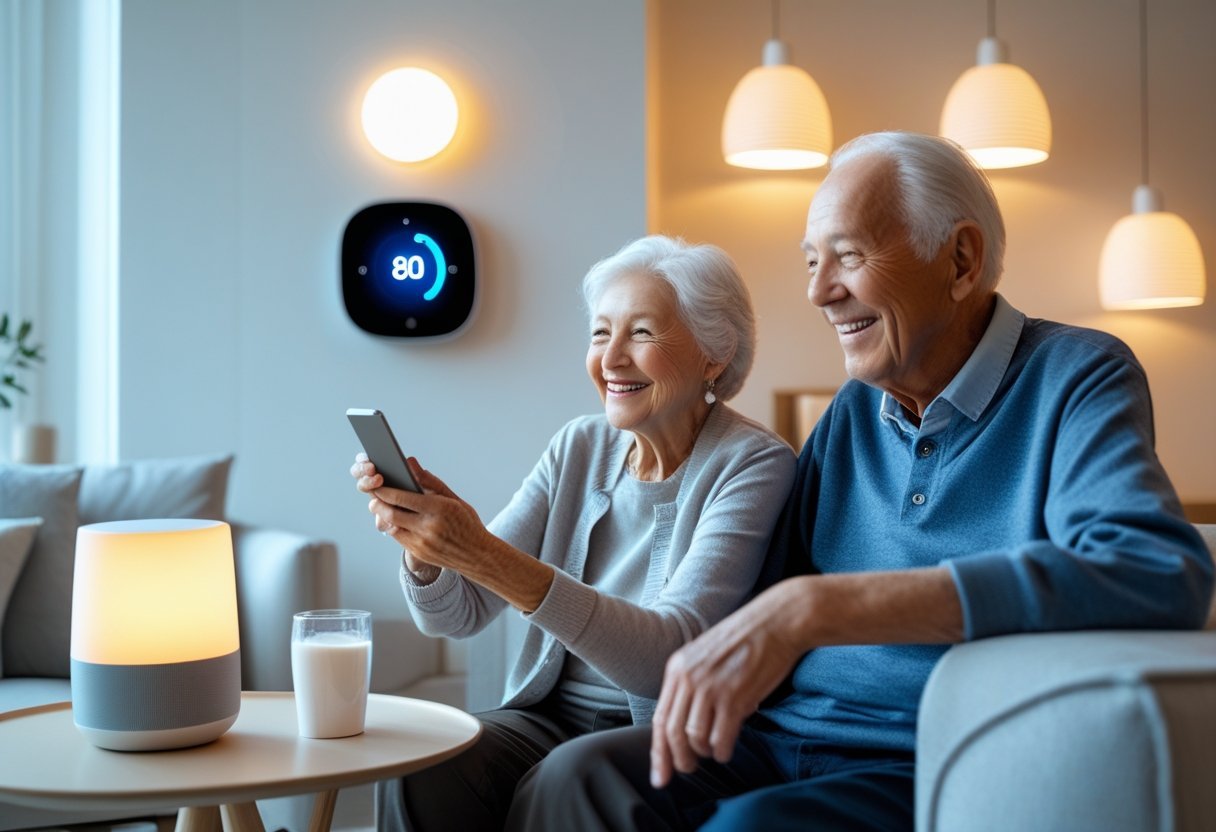
Smart lighting can help older adults stay safe and comfortable at home. These tools allow for hands-free use, reduce the risk of falls, and make it simple to adjust lighting to meet daily needs.
- The Philips Hue Smart Motion Sensor combines convenience and energy effeciency. Have your lights…
- During the night the Philips Hue Motion Sensor will switch to smart night light settings: a gentle,…
- The Philips Hue Motion Sensor can be placed freely for an optimal detection area, or mounted to a…
- CONNECTS WITH MORE LEADING SMART HOME BRANDS THAN ANY OTHER SMART HOME BRAND: Including Amazon…
- WORKS WITH: Alexa Smart Home to support dimming or switching the lights on/off through voice control…
- INCLUDES: (1) Lutron Caséta Smart Hub for Alexa Home and other smart home devices; coordinating…
- Brighter. Dimmer. Better. – Most color bulbs max out at 800lm. Tune ours brighter (1100lm/75W),…
- 16 Million Colors – Whether it’s game day or wine night, precise color control in the Wyze app…
- White Light Temperature Control – Cool it down and focus or warm it up and relax. Dedicated white…
Last update on 2025-10-02 / Affiliate links / Images from Amazon Product Advertising API
Motion-Activated Lighting
Motion-activated lighting turns on when it senses movement. This is helpful in hallways, bathrooms, and bedrooms, where seniors may need light at night.
Devices like the Philips Hue Motion Sensor and Lutron Caseta Motion Sensor are easy to set up. Once installed, they work without needing to press any switches.
These lights can reduce chances of tripping over unseen objects in the dark. Seniors with limited mobility or problems with balance can walk safely without reaching for a light. Batteries in these sensors usually last for months, and the lights can be placed nearly anywhere in the home.
Voice-Controlled Light Systems
Voice-controlled lights use devices like Amazon Echo or Google Nest speakers. With simple commands such as “Turn on the kitchen lights,” users can manage lighting without getting up.
Smart bulbs like Philips Hue or Wyze Bulb connect to Wi-Fi or Bluetooth. Setup is often done through a smartphone app, and these systems support multiple locations within the home.
For those with vision or movement challenges, voice control removes the need to find switches. Family caregivers can also manage lights remotely if needed. It is important to ensure a stable internet connection for reliable use.
Dimming and Customization Options
Dimming and color options help seniors choose the best lighting for activities. Smart lights often let users control brightness levels—from a soft night light to bright task lighting—or switch coloring based on time of day.
Products like the LIFX Bulb or Philips Hue White and Color Ambiance bulbs allow personal settings by app or voice. These features can make everyday life easier; for example, using soft lights before bed may improve sleep quality.
Some systems also offer scheduling to match routines, like turning lights on at dusk. Customization can reduce eyestrain and promote a calm atmosphere tailored to personal comfort.
Other Essential Smart Home Devices for Seniors
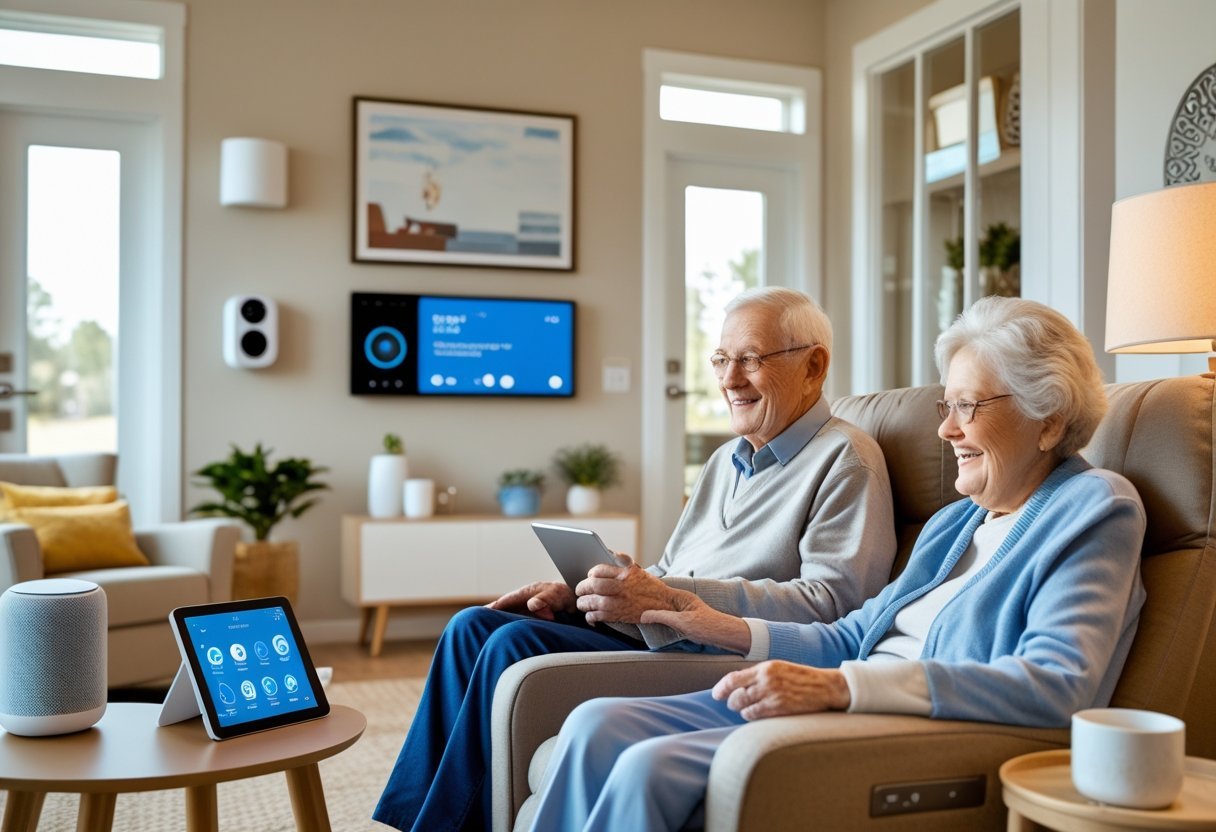
Smart door locks, home sensors, and easy video calling tools increase both safety and comfort for aging adults. These devices help seniors stay independent and connected with family or caregivers.
Accessible Smart Door Locks and Entry Systems
Smart door locks allow seniors to manage home entry without fumbling for keys. Many models use simple keypads, fingerprint scanners, or even smartphones to unlock the door. This can be helpful for those with arthritis or vision problems.
Some smart locks also let trusted family or caregivers unlock the door remotely. Features like auto-lock and emergency override settings make it easy to ensure the home is secure.
Video doorbells, sometimes part of these systems, show who is at the door on a smartphone or tablet. This makes it safer for seniors to see visitors before opening the door, reducing the risk of unwanted guests.
- YOUR LOCK ON THE OUTSIDE, A SMART LOCK ON THE INSIDE: August smart locks replace the thumbturn on…
- GET IN AND OUT WITH THE AUGUST APP: No pockets? No problem. Lock and unlock your door with the…
- AUTO-LOCKS AND UNLOCKS: Auto-Unlocks as you get home for totally hands-free unlocking — great for…
- ANYWHERE ACCESS: With built-in WiFi compatibility, you can easily and securely connect your Schlage…
- PEACE OF MIND: Lock and unlock from anywhere, manage up to 100 access codes for keyless entry, view…
- VOICE CONTROL: Works with Alexa and Google Home for optional, hands-free convenience when paired…
Last update on 2025-10-02 / Affiliate links / Images from Amazon Product Advertising API
Home Monitoring Sensors
Home monitoring sensors help caregivers know if there is a problem without invading privacy. Motion sensors placed in key spots, like hallways and kitchens, can track daily movements. If there is no motion during regular hours, caregivers can get a notification.
Sensors on doors and windows can alert family if one is opened at odd times, which helps prevent wandering, especially for those with memory loss. Water leak sensors can be placed near sinks or bathrooms to catch spills before they cause damage.
Most of these systems are simple to set up. Some come with mobile apps that let caregivers check in anytime.
- See more at your home or business — Get 66% more vertical coverage with the latest version of…
- Built-In Battery — Battery Doorbell includes a built-in battery, which charges with a convenient…
- Install in a Snap — Charge it up, click into place, and stay connected right from your phone.
- The Nest Doorbell has built-in intelligence and can tell the difference between a person, package,…
- Easily check in from anywhere 24/7 with live HD video with HDR and night vision[1]; see what you…
- If your Wi-Fi goes down or there’s a power outage, the Nest Doorbell will store up to 1 hour of…
Last update on 2025-10-02 / Affiliate links / Images from Amazon Product Advertising API
Simple Video Calling Devices
Staying connected is important for seniors, especially if family lives far away. Devices made just for video calls, like the Amazon Echo Show, Google Nest Hub, or GrandPad, let seniors use voice commands or touch screens to talk to loved ones.
These devices often have large screens and simple menus. Contacts can be preloaded, so making calls is easy, even for those who aren’t tech savvy.
Many video calling tools offer extra features, like photo sharing or reminders, to help aging adults stay engaged and informed. With just a few taps or words, they can call for help or chat with friends.
- Premium sound – Rich, detailed sound that automatically adapts to any room. Supports lossless HD…
- Voice control your music – Stream songs from Amazon Music, Apple Music, Spotify, SiriusXM, and…
- Smart home hub – Built-in hub to voice control compatible lights, locks, and sensors. Easily set…
- Designed for Seniors: GrandPad is a secure, all-in-one tablet + phone. With large icons, easy…
- Requires Activation: Call GrandPad to activate and choose from six plans—Basic, Premium, or…
- Connects the Entire Family: With our complimentary companion apps for Android and iOS, family and…
Last update on 2025-10-02 / Affiliate links / Images from Amazon Product Advertising API
Frequently Asked Questions
Smart home devices can increase safety and make daily routines easier for seniors. Many of these tools focus on emergencies, health management, and ease of use.
What smart home devices can provide immediate assistance in case of an emergency for seniors?
Voice-activated assistants like Amazon Echo or Google Nest Hub allow seniors to call for help by speaking simple commands. Medical alert systems, such as Lifeline or Medical Guardian, offer wearable devices that connect directly to emergency response teams when pressed.
Some smartwatches, such as Apple Watch with fall detection, can automatically call emergency services if a fall is detected and the user does not respond.
How do smart pill dispensers work to help elderly individuals manage their medication?
Smart pill dispensers, like MedMinder and Hero, remind seniors to take their medications on schedule. These devices light up, make sounds, or send phone alerts at the right times.
They can also lock pills until it is time for the next dose and notify caregivers if a dose is missed. This helps keep medication use accurate and safe.
Which easy-to-use smart lighting solutions are recommended for older adults?
Smart lights such as Philips Hue and Wyze Bulb can be controlled by voice or app, making it easier for seniors to turn lights on or off without moving. Some lights can be set to timers or motion sensors so they automatically turn on when someone enters a room.
Dimmable options can help seniors choose the brightness that is most comfortable for their eyes.
Can you list assistive devices specifically designed to aid seniors with disabilities?
Devices like amplified phones make it easier for those with hearing loss to stay in touch. Large-button remotes and talking clocks help seniors with vision problems. Smart doorbells with video and two-way audio, like Ring or Nest Doorbell, make it easier to see and speak to visitors from anywhere in the home.
Stove shut-off devices and smart plugs can add safety for those with memory issues, stopping appliances if left on for too long.
How do two-way communication devices enhance the safety of seniors living alone?
Two-way communication devices, like intercom systems or video doorbells, allow seniors to speak with family, caregivers, or visitors without having to move through the house. Some smart speakers can also be used for quick calls or to send messages to someone in another room.
This can be especially helpful in emergencies or if the person feels unsafe.
What are the effective strategies to overcome the challenges seniors face with using smart home technology?
Providing clear instructions, larger print manuals, and hands-on demonstrations can help seniors feel more confident with new devices. Setting up devices in advance and using simple controls, like voice commands or large buttons, reduces confusion.
Family members or caregivers should offer regular support and check that devices are working correctly. This helps seniors stay comfortable and safe while using smart home technology.
Related Reads:
1. Allergy-Proof Cleaning: Smart Devices for Dust and Pollen Relief
Smart air purifiers, robot vacuums, and HEPA filters help create a healthier indoor space — especially important for seniors with allergies or asthma.
2. Amazon Prime Day: Smart Home Deals You Shouldn’t Miss
Find senior-friendly gadgets like voice assistants, smart lights, and security devices on special offer — ideal for safer, more comfortable living.














